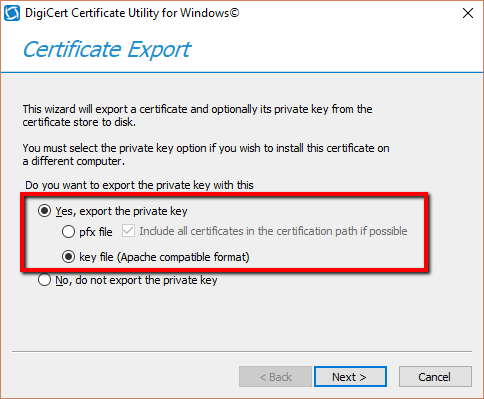Generate Pfx File From Crt And Key

- Nov 09, 2019 crt, csr, extract crt, extract pfx, pfx A.PFX (Personal Information Exchange) file is used to store a certificate and its private and public keys. For example, if we need to transfer SSL certificate from one windows server to another, You can simply export it as.pfx file using IIS SSL export wizard or MMC console.
- Windows servers use.pfx files that contain the public key file (SSL certificate file) and the associated private key file. DigiCert provides your SSL certificate file (public key file). You use your server to generate the associated private key file as part of the CSR. You need both the public.
- How to convert a PFX to a seperate.key/.crt file. What this command does is extract the private key from the.pfx file. Once entered you need to type in the importpassword of the.pfx file. This is the password that you used to protect your keypair when you created your.pfx file. If you cannot remember it anymore you can just throw your.
Crt and key files represent both parts of a certificate, key being the private key to the certificate and crt being the signed certificate. It's only one of the ways to generate certs, another way would be having both inside a pem file or another in a p12 container. In order to export the Certificate, Private Key and any intermediate certificate as a pfx file use the command below: - openssl pkcs12 -export -in my.crt -inkey my.key -certfile my.bundle -out my.pfx Note: Remember to change the names to match your file names!
This guide will show you how to convert a .pfx certificate file into its separate public certificate and private key files. This can be useful if you want to export a certificate (in the pfx format) from a Windows server, and load it into Apache or Nginx for example, which requires a separate public certificate and private key file.
In the examples below, the following files will be used:
domain.name.pfx – This will be the PFX file containing the public certificate and private key.
domain.name.crt – This is the public certificate file outputted by OpenSSL.
domain.name.key – This is the private encryption key for the above certificate outputted by OpenSSL.
Extracting the public certificate from the pfx file
Enter in the password for the PFX file when asked. You cant export the certificate or key if you don’t have this password.
You will now have the public certificate file (eg: domain.name.crt).
Extracting the private key from the pfx file
Enter in the password for the PFX file when asked. You cant export the certificate or key if you don’t have this password.
You will now have the private key file (eg: domain.name.key).
How To Create Pfx File From Crt And Key
Remove Disk from LVM Array on Ubuntu
January 6, 2013Check What Modules Were Compiled into Nginx
January 16, 2013
Format partition with the ext4 file system
June 4, 2017You have a private key file in an openssl format and have received your SSL certificate. You'd like now to create a PKCS12 (or .pfx) to import your certificate in an other software?
Secret key generator in ios. Here is the procedure!
- Find the private key file (xxx.key) (previously generated along with the CSR).
- Download the .p7b file on your certificate status page ('See the certificate' button then 'See the format in PKCS7 format' and click the link next to the diskette).
- a) Convert this file into a text one (PEM):
On Windows, the OpenSSL command must contain the complete path, for example:
c:openssl-win32binopenssl.exe ..) - b) Now create the pkcs12 file that will contain your private key and the certification chain:
You will be asked to define an encryption password for the archive (it is mandatory to be able to import the file in IIS). You may also be asked for the private key password if there is one!
You can now use the file file final_result.p12 in any software that accepts pkcs12! For IIS, rename the file in .pfx, it will be easier.
Alternatively, if you want to generate a PKCS12 from a certificate file (cer/pem), a certificate chain (generally pem or txt), and your private key, you need to use the following command: